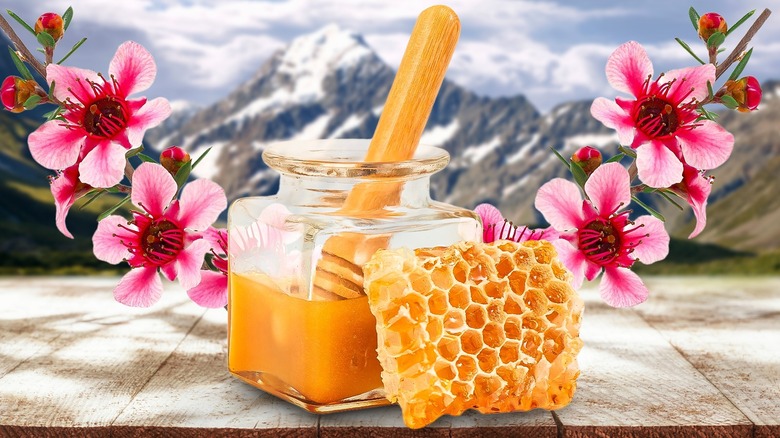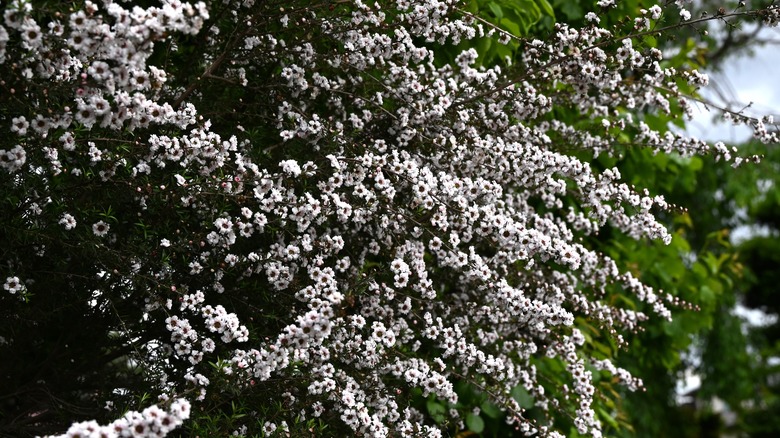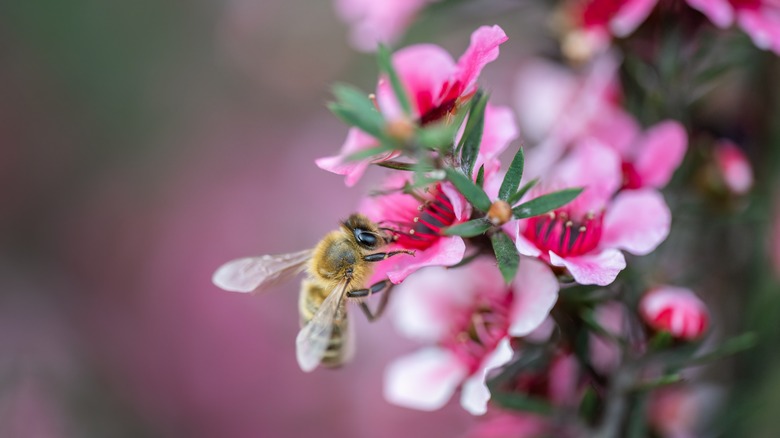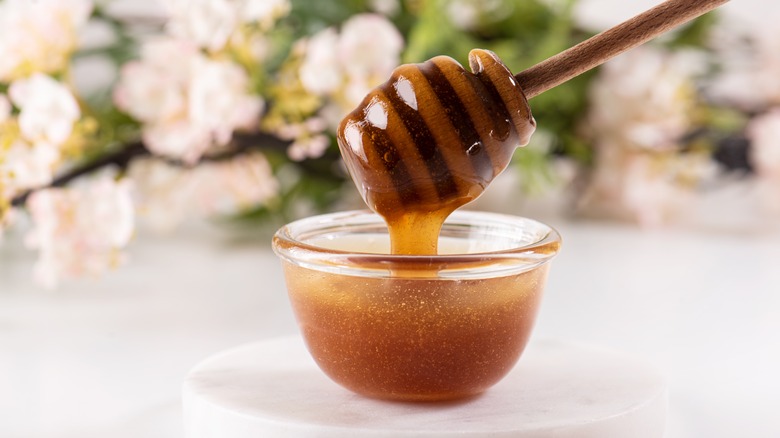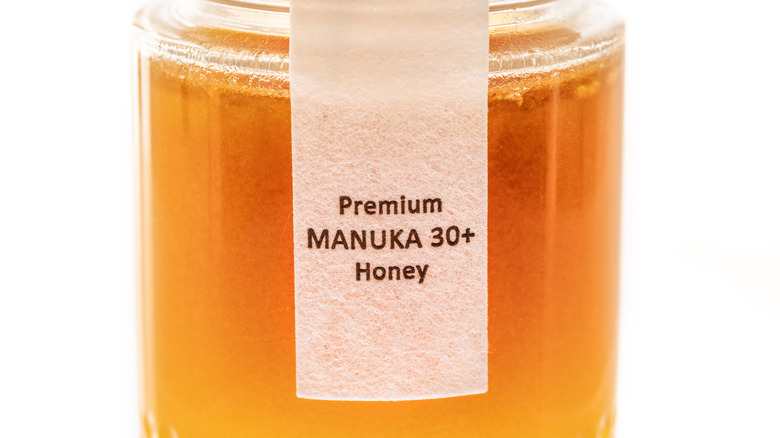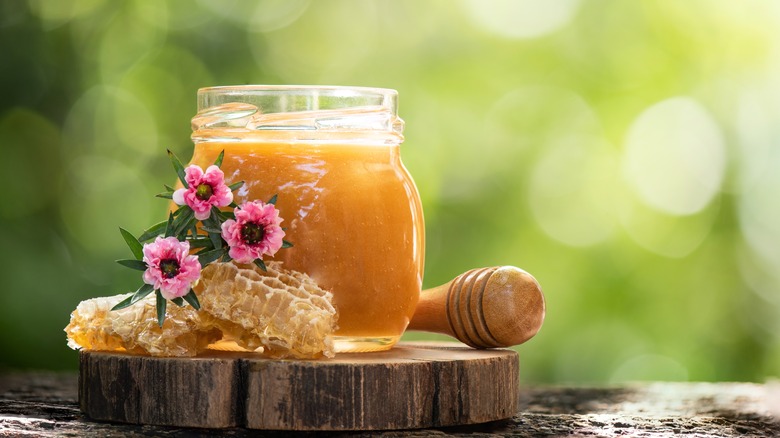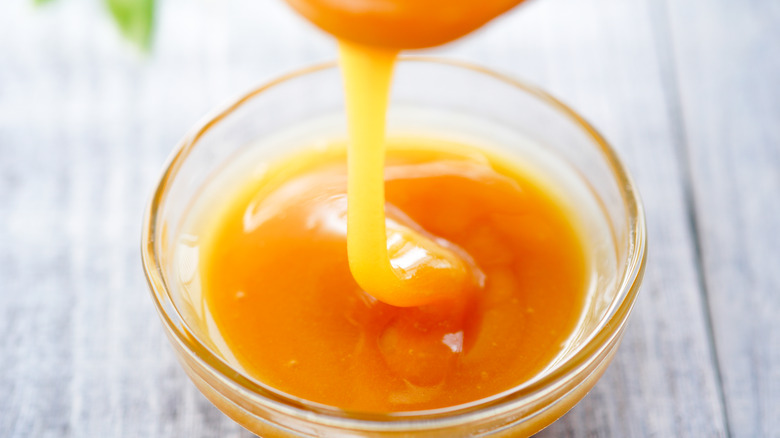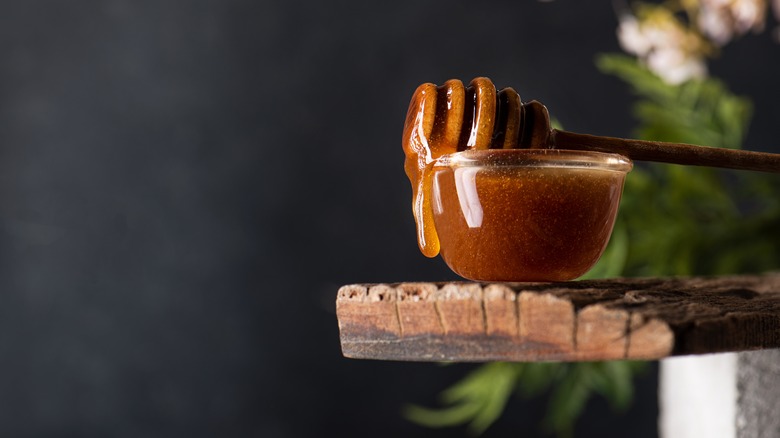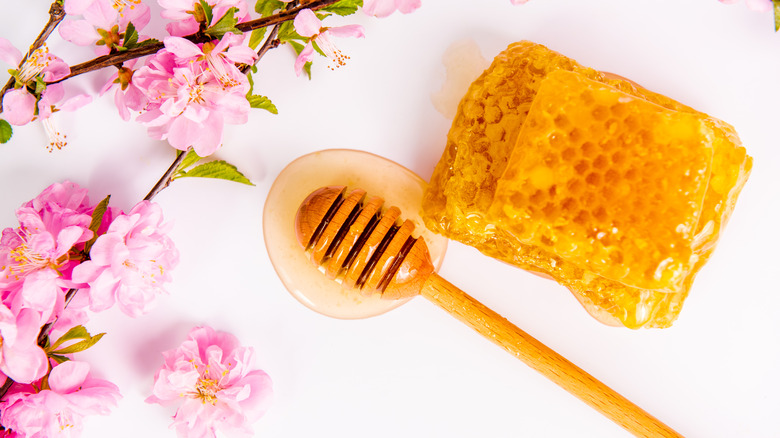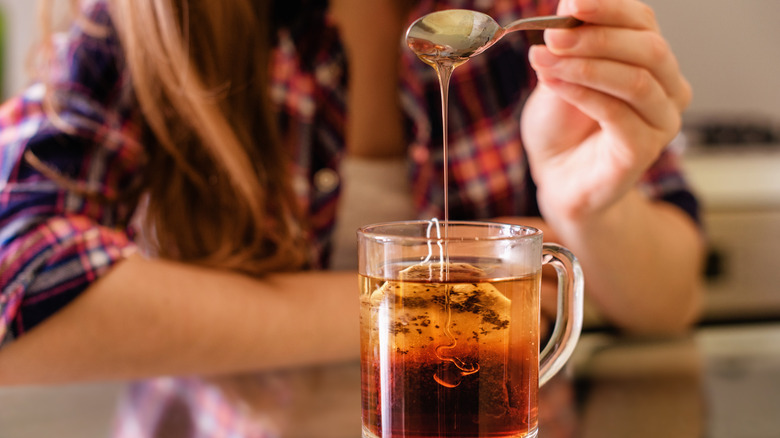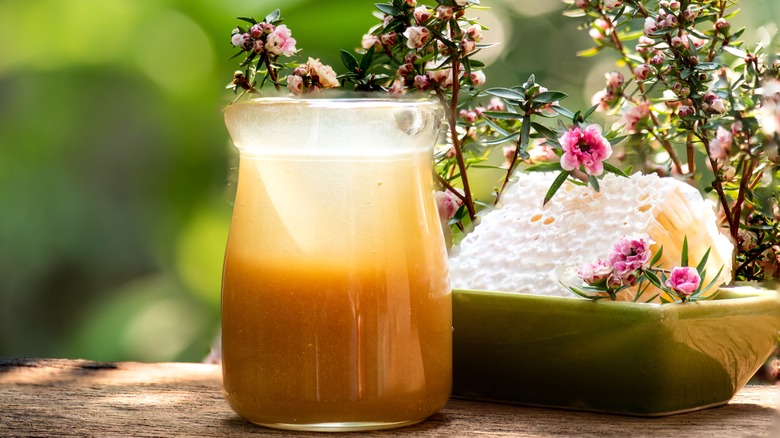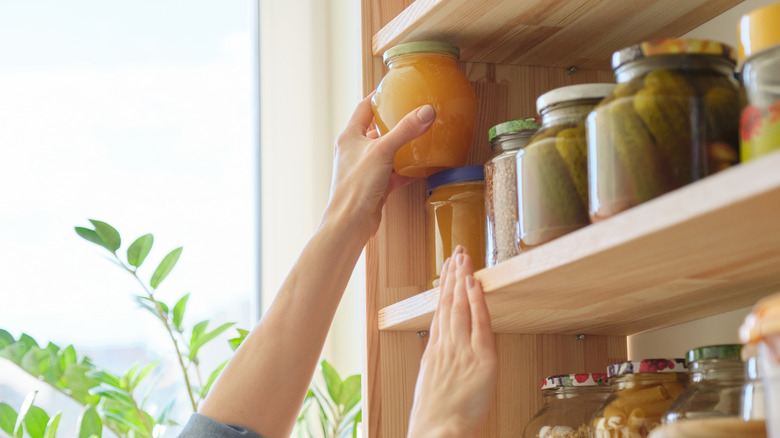What Makes Manuka Honey Special?
If you're a superfood fan, you might have heard of Manuka honey before — or maybe you've been lucky enough to spot a few jars of it at your local grocery store. Though Manuka honey often retails for a high price, it's more than just its delicate flavor that people are after. Manuka honey, produced when bees use pollen from the Manuka tree, is renowned for its many medicinal benefits. It can be eaten or used topically, which is why Manuka honey lovers across the globe hail it as a home remedy, employed for issues ranging from sore throats to cuts.
To get all the details on the special uses of Manuka honey (and what makes it so different from regular honey), you can't reach out to just any beekeeper — you need to learn from a Manuka honey farm. We reached out to Buzzstop, a Manuka honey farm in New Zealand, and spoke to Nick Cameron, the business' founder and a third-generation beekeeper, to learn about what exactly makes Manuka honey so special.
The Manuka tree
The Manuka tree (Leptospermum scoparium), which is native to New Zealand, is a beautiful tree that produces small white or pink flowers along its branches. It has a long medicinal history, and its leaves have historically been used as medicine in teas and dressings. "Manuka can flower between September and March, with a peak during November [and] January," says Buzzstop founder Nick Cameron. "A specific area might see flowering from six to 12 weeks, and individual flowers may flower for only five to six days." There is some variation for when the Manuka tree will flower geographically.
The flowers of the Manuka tree have a high medicinal value, which is a huge advantage for beekeepers; they can extract the compound by strategically placing beehives nearby to ensure that bees will use the Manuka nectar to make honey. This requires beekeepers to find massive amounts of Manuka trees — often in relatively remote locations — for bees to produce Manuka honey. In turn, the medicinal benefits are transferred from the plant to the honey — Manuka honey has MGO, an antibacterial compound only found in Manuka trees. This makes Manuka honey completely unique, and its superfood benefits can't be replicated in any other food.
The sheer volume of Manuka trees needed to make the honey also means that Manuka honey is just as native to New Zealand as the tree itself (which might make it a little difficult to get your hands on if you're not a New Zealander).
How Manuka honey is harvested
"Harvesting honey frames from beehives is largely similar globally," Nick Cameron says, but he notes that there are a few key differences you might expect to see on farms that harvest Manuka honey. Farms looking to harvest high-potency Manuka honey will drop beehives by helicopter directly into areas full of Manuka trees. Cameron says that these farms will then fly beekeepers to the hives and fly back with the frames from the beehives.
When harvesting any kind of honey, beekeepers will collect wooden frames containing the honeycomb with the honey the bees have produced inside. Each circle in the honeycomb has a wax cap over it to hold honey inside — when these caps are scraped off, the honey can then be extracted from the frames.
"Frames are then spun at high speeds in a centrifuge to extract the honey," says Cameron. Then, the honey is filtered and ready to go. But the extraction process isn't always that easy when it comes to Manuka honey.
"The kicker with Manuka honey is that, unlike normal honey, it can be more like jelly inside the frame," says Cameron. This can make the Manuka honey much more difficult to extract. "It may need to be put through a 'pricker' to physically interact with the honey to briefly turn it from jelly to liquid for long enough to spin it out," he says.
What does Manuka honey taste like?
So, what does Manuka honey taste like? It's not exactly like regular honey, but there's also not a singular defined flavor across all Manuka honey. "There can be a broad range of taste profiles within Manuka, from woody and earthy tones through to caramel and toffee," says Nick Cameron. Manuka honey is often pleasantly sweet, especially when it's a little less potent. Though, it's probably still not as sweet as other kinds of honey. "Many countries' honey is largely fake, containing around 20% honey blended with corn syrup or fructose," says Nick, which makes the flavor profile of natural Manuka honey all the more impressive.
As for what kinds of Manuka honey Cameron would recommend, he has a few favorites — including a Northern New Zealand one that he calls "simply divine." As for his favorite: "I like the ones that are really dark in color, raw if possible so they thicken and crystallize a little, with that distinctive bitterness you get on the back of your tongue due to the presence of MGO — the anti-bacterial unique to Manuka honey."
In terms of texture, the honey is probably thicker than what you might be used to consuming in your morning tea. Just like it can be during the honey extraction process, Manuka honey is sometimes described as being more jelly-like in consistency. As Cameron mentioned, Manuka honey varies in color. It can range from golden yellow to a very deep brown.
The Manuka honey rating system
Before learning more about Manuka honey's properties, it's important to understand the Manuka rating system first. Manuka honey comes with two unique rating systems to guarantee that buyers are receiving the authentic product. They also help you determine what you should use your Manuka honey for. This is because the medicinal properties of the honey vary based on its rating.
The first rating system is the UMF system, which stands for Unique Manuka Factor. You'd typically look for low-grade Manuka honey (around UMF 10+) to consume regularly, while higher-grade UMF honey (such as UMF 20+) will have more of the short-term medicinal benefits you might be looking for. Each rating of Manuka honey will have a different use medicinally, so it wouldn't be uncommon to see Manuka honey users keeping several jars with different ratings in their pantries.
The second rating system for Manuka honey is the MGO rating system, which rates the amount of methylglyoxal (MGO) in Manuka honey. MGO provides the antibacterial properties of Manuka honey. Average MGO ratings would start at around MGO 100+. This rating guarantees that there is a certain amount of MGO in the Manuka honey; for example, a rating of 100+ would contain at least 100 milligrams for every kilogram of honey. "I don't think of one rating system as better than the other," says Nick Cameron. "To me it's about understanding there is a conversion rate between them — [for example], UMF 10+ is the same as MGO 263."
The medicinal properties of Manuka honey
Manuka honey has been researched in New Zealand for a while because of its health benefits. The honey is commonly used to help treat minor illnesses and ailments at home. Manuka honey is most known for its antiviral, antibacterial, and anti-inflammatory qualities, all of which can provide long-term benefits if taken on a daily basis. However, Manuka honey is also frequently used for short-term treatments, too, which makes it useful to have on hand. "For my own family, I use a UMF 10+ to help my kids with any sore throats and winter coughs picked up at school," says Nick Cameron.
Many of those who take Manuka honey regularly use it to promote gut health or even to help keep their gums healthy, as Manuka honey has a long history of being used for dental health and hygiene. Higher-rated forms of the honey are often taken when sick, such as with a cold or flu virus. Just like how Cameron uses the honey to soothe sore throats from cold viruses, Manuka honey can help to alleviate painful symptoms from minor illnesses and also helps to support the immune system.
Manuka honey can be used topically for injuries
Though many people enjoy consuming Manuka honey for its medicinal benefits, that's not the only thing Manuka is good for. Its properties make it a highly effective as a topical ointment, too. "[The] U.S. Army uses Manuka honey on their battle dressings, it's commonplace in first-world hospitals, and is a go-to for [veterinarians] as well," says Nick Cameron. "I personally have seen some nasty wounds from the removal of skin cancers on my local customers healed up amazingly using Manuka honey."
Manuka honey has antibacterial properties that can work as an alternative wound dressing to protect wounds from infection — as Cameron mentioned, you might even see medical-grade Manuka honey being used in hospital dressings. The honey has also been known to make wounds heal faster when applied topically.
At home, you can use Manuka honey to treat small, superficial injuries that don't require other medical care, like scratches and small cuts. Manuka honey has also been used to treat small burns or irritated skin. "I have a [UMF] 20+ in the first aid cupboard at home, which I use topically for any cuts, scrapes etc. which have become infected or are slow to heal," says Cameron. "Works a treat!"
The taste of Manuka honey varies by rating
The medicinal properties of the honey aren't the only thing that changes when it comes to Manuka honey's rating. The taste can also vary significantly based on the rating of the Manuka honey you're purchasing. As the rating goes up and the medicinal properties of the Manuka honey increase, the flavor will become increasingly potent. "Certainly as the rating increases above UMF 15+ or MGO 514+, there is that defining bitter or even a metallic hit on the back of the tongue. The stronger that is, the better — it means you're getting what you paid for," says Nick Cameron.
Understanding the flavor profiles associated with each rating is just another benefit of consuming Manuka honey regularly. The lower UMF or MGO ratings will be more suitable to mix in with food, drink, or take on its own without being overwhelmingly bitter. Higher UMF or MGO ratings are more often used topically for short-term ailments or minor injury care, which means you don't need to worry as much about the taste. If you are looking for something that's relatively tasty to consume on the regular, you should stick with lower-grade Manuka honey.
How to use Manuka honey regularly
If you're planning on consuming Manuka honey regularly, you'll want to eat at least 1 teaspoon per day in order to get the maximum benefits from the honey. Some users recommend up to 2 tablespoons per day of a low-grade Manuka honey; the specific brand and type of Manuka honey you buy may also come with its own recommendations for regular use. Typically, the benefits of regular Manuka honey consumption are that it boosts the immune system and can help keep your gut healthy — it might even help with conditions you already have. Nick Cameron also recommends the honey "for stomach ulcers or digestive [tract] issues," which is another potential benefit of eating Manuka honey daily.
For anyone hoping to consume Manuka honey regularly, note that consuming any kind of honey can affect your blood sugar levels, so take medical advice into consideration before adding it to your diet. Those with bee allergies should avoid consuming the honey. For most people looking to take Manuka honey, however, there's no major limit to how much is safe to consume.
The best ways to eat Manuka honey
If you're eager to try Manuka honey, what's the best way to eat it? "Easy, always best by the teaspoon," says Nick Cameron. There's certainly nothing wrong with eating Manuka honey right out of the jar if you're interested in taking it straight. But it can add a lot of flavor to drinks like coffee or tea — and it makes a fantastic topping for any food from yogurt to bread (and yes, you can even add it to your tomatoes). Manuka honey works as flavoring or as a natural sweetener, which makes it even easier to incorporate its medicinal benefits into your daily routine.
It is, however, important to note that Manuka honey will lose its potency when heated. "Hot water above [161 F] damages honey, so avoid adding [it] to a hot cup of tea," cautions Cameron. Allow your drinks to cool slightly before adding the Manuka honey for maximum effect. Cameron uses other native New Zealand honey (many varieties of which boast similar health benefits) to use in drinks in place of Manuka. You're certainly welcome to put Manuka in hot drinks if you enjoy the taste; you won't be reaping the same health benefits from the honey if you do so.
How to purchase reputable Manuka honey
If you're buying Manuka honey for the medicinal benefits, you'll want to make sure it's legitimate. Fortunately, there's a simple way to confirm the Manuka honey you're purchasing is real. "Look on the front of the label for the UMF or MGO rating systems," says Nick Cameron. "They provide a rock-solid gauge as to the antibacterial strength of the honey and are systems that can be trusted." Reputable Manuka honey producers will go through the rating system to ensure all of their products meet the requirements, which is how you can weed out illegitimate Manuka honey products.
Cameron adds that you'll want to make sure the Manuka honey you're purchasing is from New Zealand. New Zealand has strict standards for what can be called Manuka honey, so you'll receive legitimate medicinal benefits — and it's the only country that uses only Manuka trees for the honey. Once you have the honey's rating and production location, you can guarantee you're making a safe purchase. "If it's packed in Kiwiland, it's the genuine article," says Cameron.
You might not find any Manuka honey at your local grocery store, though this certainly varies based on your location. Ordering Manuka honey straight from New Zealand farms is the easiest way to get your hands on some of the honey, which you can then have shipped straight to you. Farms like Buzzstop, for example, will have an online shop with product images, descriptions, and honey ratings.
How to store Manuka honey at home
Once you've gotten your hands on some Manuka honey, you'll want to make sure you're storing it properly. You'll likely find detailed storage instructions on the label of the honey you purchase, but there are a few general guidelines you can follow to make sure you're keeping your Manuka honey safe. Generally, you should avoid refrigerating the honey, as this could cause it to become hard and difficult to scoop. Keeping your jar of Manuka honey in a cool, dry area (like a pantry or cupboard) is best; this will ensure the honey keeps its original form, preventing it from becoming too hard or too soft. To keep the honey fresh, store it in its original container with the lid secured.
Over time, your Manuka honey will become less potent, losing its medicinal properties the longer it's kept. Manuka honey doesn't expire, but the medical grade can deteriorate if the honey is stored for long enough. Using your honey within a couple years of purchasing is usually a good idea.
